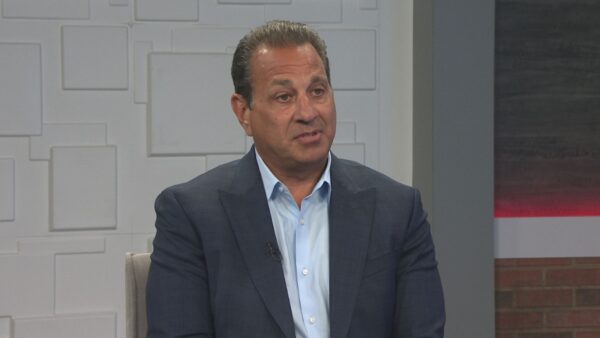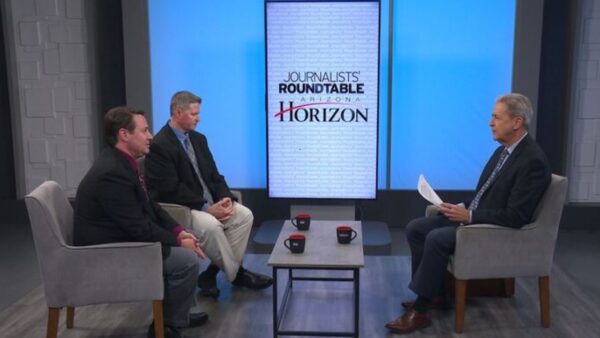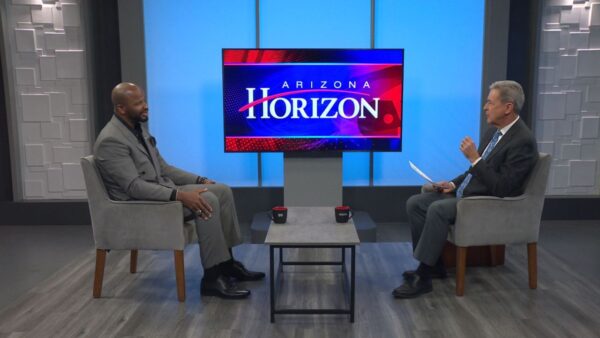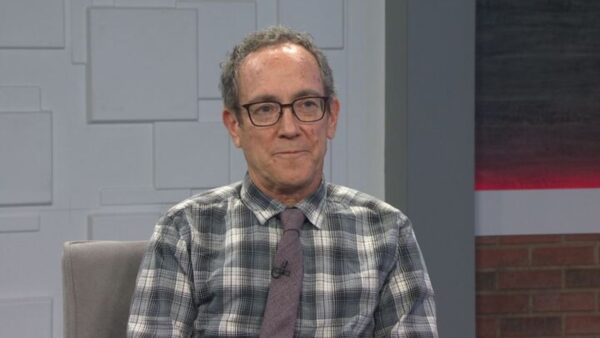Lake Pleasant is a water storage reservoir for most of the Valley’s cities. The 20th anniversary of the New Waddell Dam at Lake Pleasant is being celebrated. We’ll talk about the importance of the lake and dam to the Phoenix Metro area with Tom McCann, Assistant Director for the Central Arizona Project.
Ted Simons: Lake Pleasant is known by most as a regional center for recreation, but the lake is also an important part of the central Arizona project's diversion and storage of Colorado River water. Joining us now is Tom McCann, assistant general manager for the CAP, it's good to have you here.
Tom McCann: Thank you.
Ted Simons: And Lake Pleasant, let's figure out what Lake Pleasant is before we get too deeply into this. Where is Lake Pleasant? For those who are new to town?
Tom McCann: It's a little ways Northwest of Phoenix. Where carefree highway is, go west of I-17 and carefree highway and it's north of the highway there.
Ted Simons: Back in the old days that was out in the boonies. Not so anymore.
Tom McCann: It's now part of Peoria.
Ted Simons: And the new Waddell Dam, before we get to the new Waddell Dam, what is the Waddell Dam?
Tom McCann: The Waddell Dam was built in the 1920s. It provided irrigation water for-- And irrigation district on the west side of town, Maricopa water district, I think it was probably out in the boonies back then too. But it dammed up the Agua Fria River that comes down from the Bradshaws and that area of the state. And then in the time of C.A.P., there was a decision that we needed a place to be able to park water from the Colorado River. So there's a long story actually as to how that dam site was selected, but we built a new dam that replaced the old dam, effectively.
Ted Simons: Not only placed it, three times the water storage something along those lines?
Tom McCann: Probably more like five or six times the storage.
Ted Simons: And this is Colorado River water that is there for storage in case of what?
Tom McCann: Actually, we use it every year. We raise and lower the level of the lake every year. We pump water from the Colorado River in the winter time when the energy rates are a little lower, because it's uphill from the river, and it takes a lot of energy to move it into central Arizona. So we park the water in the lake, we fill up the lake, and in the summertime we can shut down a lot of our pumping out west from the river, saves electricity, it also allows us to do maintenance on those facilities, and then we release water from Lake Pleasant to serve the needs of Phoenix and people downstream from there.
Ted Simons: And isn't power as well -- Is it power generated in the summer or all year?
Tom McCann: Power is only generated when we release water. So it's only in the summertime. And frankly, it takes more energy to put the water in the lake than we generate bringing it out. But it helps overall with our energy bill.
Ted Simons: The new Waddell Dam, again, it's an earthen structure.
Tom McCann: That's right.
Ted Simons: This is much bigger than the old -- The old Waddell Dam is under water now isn't it?
Tom McCann: It's almost 100 feet under water. Still there, has a hole in the middle, but still there.
Ted Simons: Flying over the new one, looking at this -- I remember the story, like 20-some-odd years ago when this happened, that was a big expansion of Lake Pleasant. And things -- I'm guessing the lake has survived and folks have figured out how to enjoy it.
Tom McCann: Oh, absolutely. There are two marinas, a lot of recreational use. The water level does fluctuate during the year, but the marinas are built to accommodate that with floating docks that allow them to go up and down.
Ted Simons: As far as the cost for the new dam, what are you looking at here? Just in generalities?
Tom McCann: That's a good question. I don't know if I remember the total cost. I know what we had to kick in, the state, to provide the up front funding to build that was about $750 million, I think.
Ted Simons: And that's probably all still being repaid in one way, shape, or form?
Tom McCann: No, it's still being repaid. There were bonds issued and the bonds have since been paid off, but the cost of that dam is part of our repayment obligation to the United States.
Ted Simons: So the C.A.P., how important is Lake Pleasant, and the new Waddell Dam, but Lake Pleasant of itself, how important is that to the C.A.P.?
Tom McCann: I'd say it's really important. We don't like to highlight this particular instance, but about a year and a half ago we had an accident out west, a breach in our canal, and we were unable to deliver and move water through that segment of the canal for about three weeks. But our customers didn't see any reduction in flow because we could just turn around and take water back out of Lake Pleasant, the water we had parked there. So we were able to have uninterrupted deliveries to our customers, even though we had a canal outage that lasted three weeks.
Ted Simons: And as far as the water levels, you say they fluctuate every now and then. How much do they fluctuate?
Tom McCann: It can be as much as 100 feet in the course of the year. We usually try not to be that much. Usually try to keep it at 50-60 feet.
Ted Simons: As far as the drought is concerned, is that impacting what's happening at Lake Pleasant like it is other areas, or because it's a storage reservoir is it a whole different dynamic?
Tom McCann: It's different. Most of the water that's in there is water we put in there from pumping it from the Colorado River. We've had a few times we've had some really good runoff into the lake from the Agua Fria River, but it's not been as much in recent years.
Ted Simons: Let's talk about what happens if we get a La Nina this winter. Which they're talking about. They're looking at it. We get a lot of rain, we get overflow here and there. How does that work into it? If the Agua Fria River overflows, what happens?
Tom McCann: Well, we actually had that situation back when the dam was first being completed. It was finished in the fall of '92, but the bureau of reclamation that built it had some pretty strict criteria about how quickly to fill it up, so in '93 if you might remember there were floods on the Salt and Gila River system and there was a lot of water that came in the Agua Fria and we had to release water out of it. But we haven't had to do that since. We adolescent to release any water into the Agua Fria river since 1993.
Ted Simons: And as far as water levels right now, are they up, down? How --
Tom McCann: We're in the -- Toward the tail end of the period where we fill the lake, so we're almost to the top of where we're going to be.
Ted Simons: When you mention the lake filling and the fluctuations, do rules on the lake change when those water levels change?
Tom McCann: Hmm.
Ted Simons: Probably not --
Tom McCann: If it is, it would be the recreational folks. That would be the county.
Ted Simons: The shoreline of that cactus, watch out for the cactus-- I always thought that was fascinating. Sometimes you look under water and you're seeing the desert. At least back in the 90's. Can you still do that?
Tom McCann: Probably. My guess is since it gets covered with water once a year, it's probably not a lot of things that like that and stay growing.
Ted Simons: Last point 20 years now, is there a celebration for this?
Tom McCann: There is. I think Thursday morning.
Ted Simons: And they're basically going to say in 20 years we've -- Five to six times water capacity?
Tom McCann: We filled it and emptied it and filled it and emptied it probably about 20 times.
Ted Simons: All right. Good stuff. It's good to have you here. It's nice to learn about Lake Pleasant and the new and old Waddell Dam.
Tom McCann: Thank you.
Tom McCann:Assistant Director, Central Arizona Project;




















